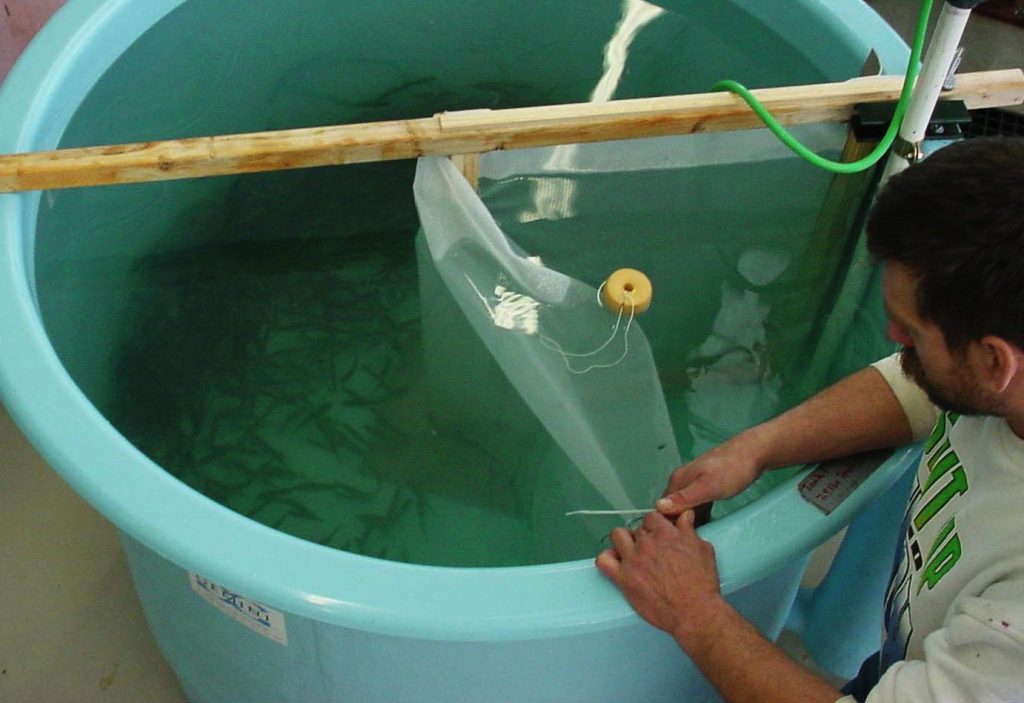
Features
RAS innovations the key to yellow perch development
January 27, 2015 By Emma Wiermaa
 New research at a Wisconsin facility is developing protocols to increase the survival of yellow perch fry reared in indoor recirculating systems
New research at a Wisconsin facility is developing protocols to increase the survival of yellow perch fry reared in indoor recirculating systemsDuring the past 30 years, yellow perch (Perca flavescens) aquaculture has received tremendous interest in the Midwest and elsewhere in the United States owing to high market demand, the decline of wild populations, and concern over micro-contaminant levels in Great Lakes. It is a particularly important aquacultural and ecological species in the Great Lakes Region (GLR) and the North Central Region (NCR).
The demand for yellow perch has remained very high in the GLR since they are the traditional fish used in local restaurants, social organizations, and the Friday-night fish fry dinners that are a staple in many Great Lakes communities. Increasing yellow perch aquaculture production helps to reduce the pressure on natural resources, therefore, sustaining and improving the ecological environment and natural resources in the Great Lakes.
The case for indoor culture
Roadblocks hindering expansion of intensive yellow perch culture have been low survival and availability of feed-trained fry and fingerlings. Pond-reared fingerlings that are feed-trained and brought indoors leave intensive systems open to a wide range of issues such as poor fish health, poor feed conversions, size heterogeneity, and often lack of sufficient numbers for commercial production. Yellow perch can reach market size in 8-12 months within a controlled environment; therefore, developing intensive, indoor culture of yellow perch has significant advantages over pond culture for commercial production in the Great Lakes and North Central Regions.
Since the 1980s many commercial ventures have attempted to use recirculating aquaculture systems (RAS) for yellow perch production but most of these attempts eventually failed. One reason was poor survival from newly hatched fry to a stage where they are completely feed-trained on commercially available diets. Specific problems seen in these early-life stages are poor feed acceptance, slow growth, non-inflation of the swim bladder and cannibalism.
Help from walleye culture
Although these issues may seem to create an obstacle for the yellow perch industry, advances in walleye culture techniques such as tank design, tank color, surface sprays, in-tank turbidity, and stocking densities have produced excellent results with walleye and hybrids and may be transferrable to other percid fishes. These advancements may shed light on our understanding of the bottlenecks associated with indoor rearing and feed training of yellow perch fry.
The University of Wisconsin-Stevens Point Northern Aquaculture Demonstration Facility (UWSP-NADF) has been conducting studies to address physical and behavioral problems and improve survival of intensively reared walleye and hybrid walleye fry in cooperation with Dr. Robert Summerfelt and Alan Johnson (Iowa DNR).
According to Summerfelt, author of the Walleye Culture Manual, intensively reared walleye have many of the same problems with fry culture as those documented for yellow perch. The physical and behavioral problems with these fry include non-inflation of the swim bladder, clinging behavior, low feed acceptance, and cannibalism.
Successful techniques
Summerfelt and Johnson have found that in walleye, these problems can be overcome by using a combination of various techniques. These include increased water turbidity, directional water inflow, controlled lighting, dark room environment, dark tank coloration, and water spray on the surface of the tank to minimize the coverage of the water surface with particles and films that impede swim bladder inflation.
Using these methods, UWSP-NADF personnel have now been able to produce sufficient purebred and hybrid walleye fingerlings in indoor intensive systems to aid the fledgling walleye food-fish industry into commercial-scale production. Similar approaches may address the questions related to early-life stage mortality of intensively raised yellow perch.
Husbandry transfer
Due to the extensive research and success in intensively raising walleyes at UWSP-NADF, the USDA-North Central Region Aquaculture Council (NCRAC) provided funding to investigate and develop systems and diet strategies to reduce yellow perch fry mortality at the commercial-scale. Working collaboratively with the Ohio State University-South Centers and Iowa State University, the UWSP-NADF is currently rearing yellow perch intensively and investigating different attributes such as tank color, spray bar effects and turbidity levels. The facility just completed the first year of research and will be continuing this study in 2015-16.
Results gathered from this commercial-scale research will be incorporated into an overall report including an executive summary about culture strategies and protocols that can be used to increase the survival of yellow perch fry in indoor recirculating systems using culture methods and feeding regimens that maximize mass production. The greatest return on investment for this project is the ultimate reduction in production costs due to increased growth rate and survival of yellow perch fry by using tank systems and feeding regimes optimized for the early-life stage.
Online training modules
Another important benefit is providing technology for producing feed-trained fingerlings that have been reared entirely on formulated diets. At the completion of this project, we expect to have information available about culture system components and recommended management strategies including feeding, spray bar use, turbidity, and tank colors, for successfully reducing the early-life stage bottlenecks.
Online training modules will be made available through the NCRAC and UWSP-NADF website for aquaculturists. These new methodologies may greatly improve yellow perch fry survival and help feed the continued interest in RAS production of yellow perch for the food fish industry.
— Emma Wiermaa
Emma Wiermaa is an Outreach Specialist with the University of Wisconsin-Stevens Point Northern Aquaculture Demonstration Facility.
Print this page